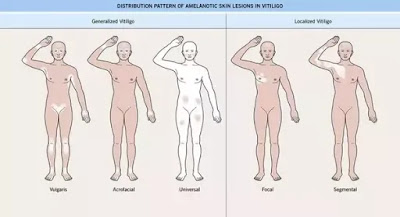What causes vitiligo?
What causes vitiligo?
People are not born with vitiligo - this skin pathology begins to develop under the influence of various factors subsequently; factors can be both internal and external.
People are not born with vitiligo - this skin pathology begins to develop under the influence of various factors subsequently; factors can be both internal and external.
The disease occurs very infrequently in infancy; usually, the first signs can be noticed after a child turns 10 years of age. Interestingly, there is a proven relationship between the appearance of vitiligo and periods of increased sunlight activity in the spring and summer.
However, solar activity, cannot be declared the main reason for the appearance of vitiligo.
Some serious conditions leading to vitiligo may include:
- Autoimmune Disorder - Various disorders in the immune system are the cause of many serious conditions, including vitiligo. A simple description of what is happening is an attack on the immune system on your own healthy cells and tissues. They are perceived as invaders, as agents of the other, subject to destruction. The link between the autoimmune reactions of the organism and the appearance of vitiligo is proven by the fact that people with vitiligo usually develop some of the most common autoimmune diseases - rheumatoid arthritis, thyroid diseases or lupus erythematosus.
- Heredity - The genetic impact of vitiligo sufferers has been proven experimentally by a scientific team at the State University of Colorado. It is clear that there is a family predisposition to this type of skin pathology. In addition, claims regarding particular correlations are also proven to be true: for example, brown-eyed people more often develop vitiligo than blue-eyed and gray-eyed people.Fundamental factors for the development of the condition can be the adrenal gland, the pituitary, the pancreas or even the ovaries.
- Skin Trophy Disorders: Reasons for the abnormal metabolism of these tissues may be burns - solar or thermal, chemical, scarring, various traumas. Vitiligo often develops on a skin area that has been injured, experienced an inflammatory process and is affected by an autoimmune component. Cells producing pigment melanin begin to break down. The more often the skin is exposed to the sun, the faster the depigmentation process.
- Medications. Taking some medicines can also trigger the pathological process.
- Some diseases affecting the liver where stagnation of bile juices and changes in liver parenchyma occur. Liver enzymes are incredibly high, which can be confirmed by a routine blood test. Usually, the appearance of vitiligo is immediate.
- Diseases of the gastrointestinal tract: dysbacteriosis, malabsorption. Because of these disorders, the skin does not get the necessary nutrients to form melanin - including copper, zinc, manganese, magnesium, and feldaldehyde.
In fact, doctors are not wrong in saying that the appearance of vitiligo is a powerful signal of the body for a serious health problem. Very often the disease starts after a viral infection, intoxication, after physical trauma. Especially dangerous in this respect are the head traumas.
Is it curable?
Vitiligo is an extremely persistent disease that is very difficult to treat. That is why the patient must arm himself with great patience, perseverance, and faith if he wants to treat the condition successfully.
Vitiligo, especially in the initial phase, may be considered a totally treatable illness if the patient has the will, courage, confidence, persistence in complying with the recommendations prescribed.
How can it be treated?
If a white spot suddenly appears on your skin or if there are several lesions on the skin- do not wait until it disappears, because it may not happen. Immediate appointment with a doctor is highly recommended. In particular, go straight to a dermatologist who can immediately determine the type of depigmentation on your skin. According to your treatment plans, your doctor may ask for a detailed physical exam and take your skin material for a specialized lab. Sometimes this is simply because a number of skin diseases in their initial phase have very similar symptoms to those of vitiligo.
Although there are particular cases of spontaneous repigmentation and rehabilitation without interference - you shouldn’t rely on that. There is a high risk for the disease to progress if you do not start treatment as early as possible. Treatment at a progressed stage always requires stronger medications well as more aggressive treatment. As mentioned above, there is parallel with vitiligo and other diseases, so treatment is likely to be complex and will be a signal for at least one other health problem. It is very important to find an experienced physician who has a practice with the application of preparations from different groups and their proper reconciliation.
Very often, treatment begins with glucocorticosteroids. The goal is to suppress autoimmune processes and allergic reactions in the body. This type of treatment is preferred in the following cases:
The localized form of the disease: topical products such as hydrocortisone butyrate are suitable. This type of ointments are applied for three months, and then - if there is no improvement, products with higher activity are recommended, such as creams and ointments. Such medications are not used for more than 8 weeks without a pause. If it is necessary to continue treatment, it may take one to four months, as your physician determines.
The generalized form of the disease: in this case, it is necessary to take tablets. However, taking glucocorticosteroids in this way increases the risk of diabetes, so medications are taken with interruptions. In addition, pulse therapy - short intravenous infusion of a high dose of corticosteroid. Thus, treatment with dexamethasone, triamcinolone, prednisolone, methylprednisolone occurs.
The use of ultraviolet radiation is often used to treat vitiligo and for this reason, doctors recommend taking photosensitizing agents - furanocoumarins such as pyranic, oxalic, methoxelic, melanidinic. Their role is to increase the sensitivity of melanocytes to ultraviolet effects.
Systemic therapy may also be prescribed in order to treat hormonal disorders, while preventing depressive conditions in patients, eliminating nervous and mental problems - all things that can provoke the development of vitiligo. During the treatment period, the patient should take vitamins and various elements if a particular deficiency is found. It is also good to include antioxidants and immunomodulators in the daily intake during the process of treatment.
As with other illnesses, modern medicine is constantly seeking new methods and options available for the successful treatment of the condition. Here are some of them:
PSEUDOCATALASE
Catalase is an enzyme that can be detected normally in the skin. This enzyme reduces skin damage caused by free radicals. There is a scientific evidence that in the skin of people with vitiligo the enzyme catalase is lowered.
Pseudocatalase is administered for the treatment and the aim is to replace the normal enzyme. Pseudocatalase is used in combination with UVB 311. Pigmentation can be restored and disease progression prevented.
UVB THERAPY
The most commonly used therapy for minimizing the symptoms of generalized vitiligo is the phototherapy with UVB 311 nm narrowband phototherapy.
It is believed that the effect of this type of therapy is due to local immunosuppression, stimulation of melanocyte-stimulating hormone formation, increased melanocyte proliferation and acceleration of the pigment formation process.
The advantages of narrow-band UVB phototherapy are due to the safety way of use for both adults and children. This therapy is not toxic, no additional eye protection is required during the procedure.
UVB phototherapy shows greater effectiveness than PUVA treatment and is also less likely to have side effects.
EXCIMER LASER
In the treatment of localized vitiligo, usually, an excimer laser is the most proper therapy. The Excimer Laser is a device that generates UVB rays with a wavelength of 308 nm.
Treatment with an excimer laser can be combined with calcineurin inhibitors and is very appropriate in acro pharyngeal vitiligo. A better effect is achieved on the facial area comparing to the palms and soles.
The excimer laser treatment course is three times a week for at least 12 weeks.
PUVA THERAPY
PUVA therapy can be done with systemic or local means. PUVA treatment uses substances called psoralens. Oral psoralens can be orally or locally administrated (by spraying).
Psoralens are photosensitizing substances which should be combined with the use of UVA rays – ultraviolet rays with a wavelength of 320 nm to 400 nm.PUVA therapy is performed 2-3 times a week. Conducting PUVA therapy is associated with side effects and is therefore no longer one of the commonly used vitiligo treatment methods.
BETA-CAROTENE
The use of beta-carotene can cause pigmentation of the skin (yellow-orange shade). This is due to the accumulation of vitamin in the stratum corneum.
Beta-carotene therapy starts with a dose of 25 mg 3 to 5 times a day, and after 4-5 weeks the dose is reduced twice daily.
The use of beta-carotene is contraindicated in the presence of kidney or liver disease. Beta-carotene treatment is suitable for people with light skin and is pointless for people with dark skin.
Note that obtaining a yellow-orange nuance of the skin is not always a cosmetically acceptable result.
See more: Vitiligo: Symptoms, Causes & Treatment - SkinPractice




Comments